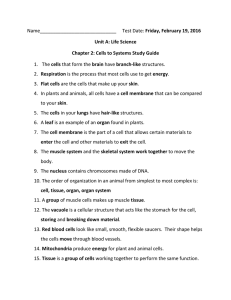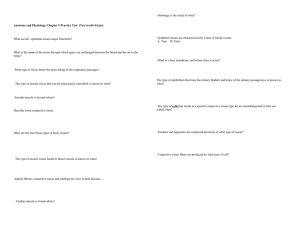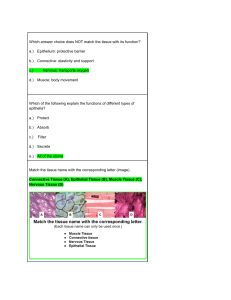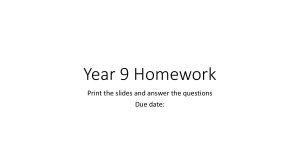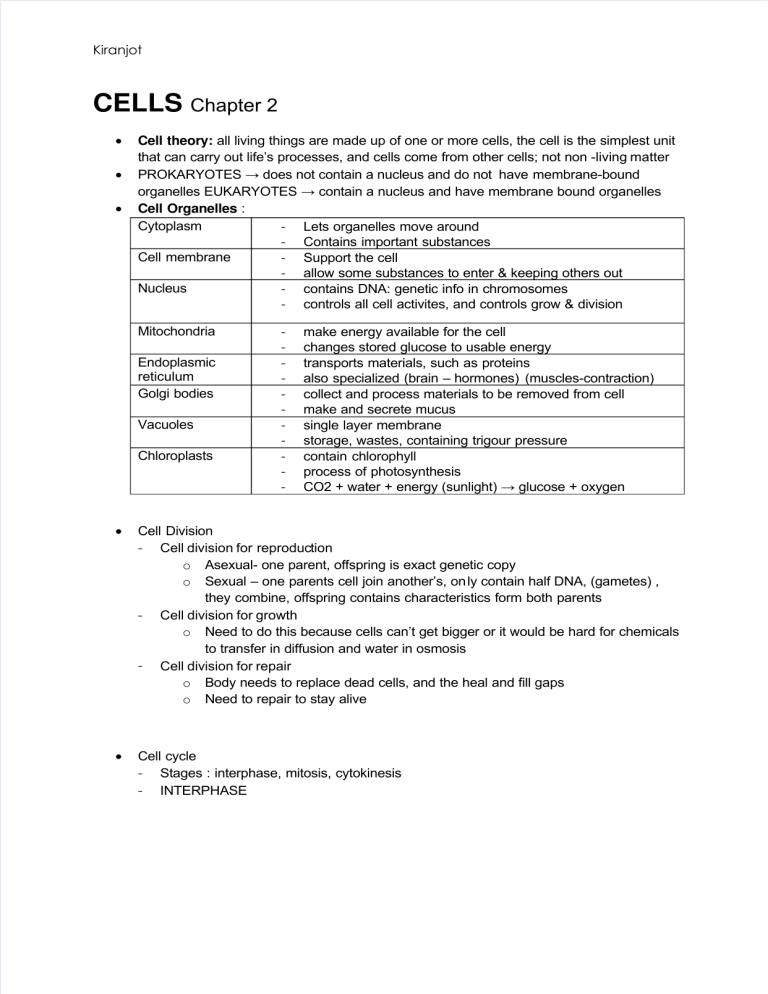
Kiranjot CELLS Chapter 2 Cell theory: all living things are made up of one or more cells, the cell is the simplest unit that can carry out life’s processes, and cells come from other cells; not non -living matter PROKARYOTES → does not contain a nucleus and do not have membrane-bound organelles EUKARYOTES → contain a nucleus and have membrane bound organelles Cell Organelles : Cytoplasm - Lets organelles move around - Contains important substances Cell membrane - Support the cell - allow some substances to enter & keeping others out Nucleus - contains DNA: genetic info in chromosomes - controls all cell activites, and controls grow & division Mitochondria Endoplasmic reticulum Golgi bodies Vacuoles Chloroplasts - make energy available for the cell changes stored glucose to usable energy transports materials, such as proteins also specialized (brain – hormones) (muscles-contraction) collect and process materials to be removed from cell make and secrete mucus single layer membrane storage, wastes, containing trigour pressure contain chlorophyll process of photosynthesis CO2 + water + energy (sunlight) → glucose + oxygen Cell Division - Cell division for reproduction o Asexual- one parent, offspring is exact genetic copy o Sexual – one parents cell join another’s, on ly contain half DNA, (gametes) , they combine, offspring contains characteristics form both parents - Cell division for growth o Need to do this because cells can’t get bigger or it would be hard for chemicals to transfer in diffusion and water in osmosis - Cell division for repair o Body needs to replace dead cells, and the heal and fill gaps o Need to repair to stay alive Cell cycle - Stages : interphase, mitosis, cytokinesis - INTERPHASE Kiranjot The phase of the cell cycle during which the cell performs its normal functions and its genetic material is copied for preparation for cell division MITIOSIS o The stage of the cell cycle in which the DNA in the nucleus is divided; the first part of cell division, to produce the daughter cells o Contains PMAT; Prophase, Metaphase, Anaphase, Telophase Prophase Chromosomes become visible by condensing DNA strands, & nuclear membrane is breaking down Metaphase Chromosomes (sister chromatids connected by centromere) line up in the middle of the cell, & nuclear membrane completely gone Anaphase Centromere in sister chromatids split, now called daughter chromosomes, start moving to opposite sides of cell Telophase Daughter chromosomes stretch out, become thinner, a new nuclear membrane form around each of them; appears to have two nuclei CYTOKINESIS o Cytoplasm divided, producing two identical daughter cells o Plants have a cell plate, which develops into a cell wall o Animals the membrane is pinched off in the center Reasons not to divide are signals from other cells no to, not enough nutrients, DNA not copied, DNA is damaged o - - - Cancer-Cell Division Gone Wrong - Cells that divide despite messages to stop , rapidly growing makes a lump or tumor - Stays together, not serious is a benign tumor, a tumor that interferers is a cancerous tumor, malignant they can leave tumor and start somewhere else metastatic - Causes of cancer can be random mutations caused by carcinogens or hereditarily which is passed on - Super foods that can fight cancer are nuts, and tomatoes Specialized Cells - All multicellular organism have specialized cells; perform specific functions - Performs one function, instead of doing everything - Ex: o Red blood cells – contain hemoglobin that carries oxygen in blood. Cells are smooth so they can easily pass through blood vessels o Skin Cells – fit tightly together, covering the outside of the body, to protects it and reduce water loss Kiranjot o Nerve cell- long and thin and have many branches, conduct electric impulses to coordinate body activity ANIMAL SYSTEMS Chapter 3 The Hierarchy of Structures - Organism (human) → organ system (circulatory system) → organ (heart) → tissue (cardiac muscle) → cellular level (cardiac muscle cell) - 4 major type of tissue o Epithelial Thin sheet of tightly packed cells that covers body’s surfaces, and lines internal organs and body cavities o Connective A specialized tissue that provides support and protection for various parts of the body o Muscle containing proteins that can contract and enable the body to move o Nerve That conducts electric signals from one part of the body to another The Digestive System - Tract includes mouth, esophagus, stomach, small intestine, large and anus o MOUTH – breaks down food with teeth and tongue, and chemically with enzymes o ESOPHAGUS - muscular tube, contract and relax , slowl move food along o STOMACH – hold and churns food, lining contains enzymes and acids o INTESTINE – goblet cells produce mucus, muscles churn and contract food, nutrients diffuse into blood stream, large intestine lining absorbs water o ANUS – remaining food not diffused it excreted form here - Accessory Organs o Liver, pancreas, gall bladder Supply digestive enzymes Pancreases produces insulin that controls sugar in our blood Circulatory System - Has the blood, heart and blood vessels - Transports oxygen and nutrients throughout the body and carries away wastes o BLOOD red blood cells o half of our blood, contain hemoglobin which carries oxygen white blood cells Kiranjot infection fighting cells, 1% o have nucleus platelets o Tiny cells that prevent blood clotting Plasma o Protein rich liquid that carries blood cells along ½ blood is plasma o THE HEART Made up of three different types of tissue, muscle tissue, nerve tissue and connective tissue o Cardiac muscle is the only found in the heart, make the heart contract at the same time and moves the blood around the body o Heart rate depends on stress, temperature and health o Inner an outer surfaces of the hearth lined with epithelial tissue, it reduces friction and the blood can flow easily o BLOOD VESSELS Arteries – carry blood away from the heart, they have thicker walls Veins- carry blood toward the heart Capillaries- further, they are more vessels that are linked together, tiny blood vessels with thin wall which allow diffusion Can have diseases like coronary artery disease, that is cause by plaque in the vessels (fat) to block the passage of blood, making it work harder o When coronary arteries are completely block, and they can’t get their oxygen and nutrients, the heart stops pumping and the cardiac muscle starts to die: Heart Attack o - Respiratory System - Made up of mouth, nose, trachea, bronchi, lungs - Provides oxygen for the body and allows CO2 to leave the body - Air enters throughout the mouth and nose, passing into the pharynx, travels throughout the trachea, which separates into two bronchi and bronchi deliver to the lungs o Cilia help move mucus and filter our any foreign material, cilia, are in the epithelial cells in the trachea and bronchi o Each bronchi branches again and again to alveoli Have very thin walls and are lined with capillaries Oxygen and CO2 diffuse through their thin walls - Breathing controlled by muscles, and their expansion and relaxation, muscle move the rib, and the diaphragm moves Organ transplant - Living donors, mostly relatives of the recipient, rick of rejection Kiranjot - Deceased donors, they take it from your consent when alive or your families after you die, they check for disease and give it to the person with the best match Xenotransplant, transporting bodies from different animals to another; rejection is very common Musculoskeletal System - Organ system made up for bones and skeletal muscle, that supports the body, and protects it, and make movement possible o Skelton made up of bones (hard and dense, made up of a matrix of materials), ligaments (tough, elastic connective tissue, made up of long fibres of collagen), cartilage (dense connective tissue, also matrix of collagen fibres, flexible) o The rest are muscles, muscle tissue have bundle of long cells called muscle fibres Proteins cause them to contract- get shorter and thicker Skeletal muscle is one of thee types of muscle tissue it is voluntary The others are (involuntary) smooth muscle is mostly in the intestines and cardiac muscle in the heart o Skeletal muscle is attached to bones by tendons, allowing movement of body parts - How muscles make bones move o Tendons are similar to ligaments but are less elastic and connect muscles to bones, when contracted in response to signal from the nervous system exert force, force move one or both the muscle in connected to, muscles can pull but can’t push, so they work in opposing pairs or groups: BICEPS (contracted when folded) AND TRICEPS (contracted when straight) - Loss of bone tissue can cause osteoporosis, drink milk, usually in old woman Nervous System - Made up of the brain, the spinal cord, and peripheral nerves - The system that senses the environment and coordinates appropriate responses - Core of the nervous system – central nervous system ; brain and spinal cord o Nerves carry signals between the CNS and PNS (peripheral nervous system) PNS relays on info from internal and external environments from he brain Relays on instructions from the brain to other parts of the body to control many of the body’s functions o Nerves that control voluntary muscle o Nerves that carry info from sensory organs, to brain o Nerves that regulate involuntary functions - Nerves are made up of bundle of neurons, each surrounded by connective tissue, nerve cell →myelin sheath - Diseases and injures can be very dangerous Kiranjot PLANT SYSTEMS Chapter 4 Systems in Plants o Two main body systems, SHOOT (leaves, stems, flowers) and ROOT ROOT - Anchors the pant, absorbs water and mineral and stores food SHOOT – specialized to product photosynthesis and reproduce sexually o They do not move around thus they do not need complex and coordinated organ systems found in animals But they do need to exchange gases with their surroundings Require internal transport system to move water and nutrients They must have a way of reproducing o Three main types of plant tissue Dermal tissue system – made up of tissues that form the outer surfaces of plant parts Epidermis on leaves Periderm on woody plants Vascular tissue system- made up of tissues specialized for the transportation on water and minerals Ground tissue system is all those other than vascular and dermal o SHOOT SYSTEM PARTS Leaf Main photosynthetic structure tissues in leaf use CO2, water and light energy to produce glucose and oxygen Chloroplast perform photosynthesis with chlorophyll o Located in the palisade layer and spongy mesophyll o Palisade cells are located where there max sunlight; just below leafs upper surface – layer of tall, closely packed cells containing chloroplasts o Spongy mesophyll is within the interior – a region of loosely packed cells containing chloroplast in the middle of the leaf Some leaves can support, protect and attract Flower Specialized for attraction, eggs fertilized by pollen, after it becomes a seed Pollination can occur with the help of animals or by the wind The stem Supports branches and leafs Provides a way for transport o Xylem- transports water and dissolved minerals from the roots to the leaves and stems of the plants, GO UP THROUGH DIED CELLS Kiranjot Phloem- transports dissolved food minerals and hormones throughout the plant and glucose Some stem specialized for protection, photosynthesis, and reproduction o

